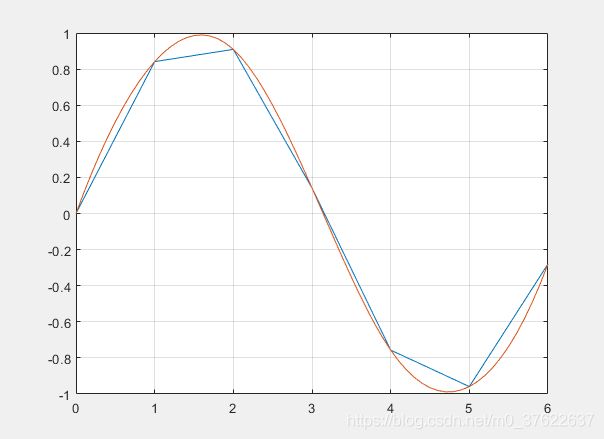C语言 - 实现三次样条插值(Spline)
本文代码主要参考于百度知道:金色潜鸟 - 百度知道的回答。
他的程序代码有一个很小但较为严重的bug,所以在这对代码修正。
完整代码在文末,欢迎交流讨论。
说明:
文中以及代码中,
x、y分别代表插值前的横纵坐标;
u、s分别代表插值后的横纵坐标。
我在测试中,发现他的程序中有bug,即seval()函数中,给 j 赋的初值是插值后横坐标序列(u)的长度,会导致 u 长度超过一定值后,s数组的值会产生错误。(我测试u长度为21时会出错)
正确的方法:应该是给 j 赋值插值前横坐标序列(x)长度
故应seval()函数中,添加插值前横坐标序列(x)长度,即:
double seval(int n, double u,
double x[], double y[],
double b[], double c[], double d[],
int *last);改为
double seval(int ni, double u,
int n, double x[], double y[],
double b[], double c[], double d[],
int *last);
完整代码如下:
#include "stdafx.h"
#include "spline.h"
#include
static int spline( int n, int end1, int end2,
double slope1, double slope2,
double x[], double y[],
double b[], double c[], double d[],
int *iflag)
{
int nm1, ib, i, ascend;
double t;
nm1 = n - 1;
*iflag = 0;
if (n < 2)
{ /* no possible interpolation */
*iflag = 1;
goto LeaveSpline;
}
ascend = 1;
for (i = 1; i < n; ++i) if (x[i] <= x[i - 1]) ascend = 0;
if (!ascend)
{
*iflag = 2;
goto LeaveSpline;
}
if (n >= 3)
{
d[0] = x[1] - x[0];
c[1] = (y[1] - y[0]) / d[0];
for (i = 1; i < nm1; ++i)
{
d[i] = x[i + 1] - x[i];
b[i] = 2.0 * (d[i - 1] + d[i]);
c[i + 1] = (y[i + 1] - y[i]) / d[i];
c[i] = c[i + 1] - c[i];
}
/* ---- Default End conditions */
b[0] = -d[0];
b[nm1] = -d[n - 2];
c[0] = 0.0;
c[nm1] = 0.0;
if (n != 3)
{
c[0] = c[2] / (x[3] - x[1]) - c[1] / (x[2] - x[0]);
c[nm1] = c[n - 2] / (x[nm1] - x[n - 3]) - c[n - 3] / (x[n - 2] - x[n - 4]);
c[0] = c[0] * d[0] * d[0] / (x[3] - x[0]);
c[nm1] = -c[nm1] * d[n - 2] * d[n - 2] / (x[nm1] - x[n - 4]);
}
/* Alternative end conditions -- known slopes */
if (end1 == 1)
{
b[0] = 2.0 * (x[1] - x[0]);
c[0] = (y[1] - y[0]) / (x[1] - x[0]) - slope1;
}
if (end2 == 1)
{
b[nm1] = 2.0 * (x[nm1] - x[n - 2]);
c[nm1] = slope2 - (y[nm1] - y[n - 2]) / (x[nm1] - x[n - 2]);
}
/* Forward elimination */
for (i = 1; i < n; ++i)
{
t = d[i - 1] / b[i - 1];
b[i] = b[i] - t * d[i - 1];
c[i] = c[i] - t * c[i - 1];
}
/* Back substitution */
c[nm1] = c[nm1] / b[nm1];
for (ib = 0; ib < nm1; ++ib)
{
i = n - ib - 2;
c[i] = (c[i] - d[i] * c[i + 1]) / b[i];
}
b[nm1] = (y[nm1] - y[n - 2]) / d[n - 2] + d[n - 2] * (c[n - 2] + 2.0 * c[nm1]);
for (i = 0; i < nm1; ++i)
{
b[i] = (y[i + 1] - y[i]) / d[i] - d[i] * (c[i + 1] + 2.0 * c[i]);
d[i] = (c[i + 1] - c[i]) / d[i];
c[i] = 3.0 * c[i];
}
c[nm1] = 3.0 * c[nm1];
d[nm1] = d[n - 2];
}
else
{
b[0] = (y[1] - y[0]) / (x[1] - x[0]);
c[0] = 0.0;
d[0] = 0.0;
b[1] = b[0];
c[1] = 0.0;
d[1] = 0.0;
}
LeaveSpline:
return 0;
}
static double seval(int ni, double u,
int n, double x[], double y[],
double b[], double c[], double d[],
int *last)
{
int i, j, k;
double w;
i = *last;
if (i >= n - 1) i = 0;
if (i < 0) i = 0;
if ((x[i] > u) || (x[i + 1] < u))//??
{
i = 0;
j = n;
do
{
k = (i + j) / 2;
if (u < x[k]) j = k;
if (u >= x[k]) i = k;
} while (j > i + 1);
}
*last = i;
w = u - x[i];
w = y[i] + w * (b[i] + w * (c[i] + w * d[i]));
return (w);
}
void SPL(int n, double *x, double *y, int ni, double *xi, double *yi)
{
double *b, *c, *d;
int iflag=0, last=0, i=0;
b = (double *)malloc(sizeof(double) * n);
c = (double *)malloc(sizeof(double) * n);
d = (double *)malloc(sizeof(double) * n);
if (!d) { printf("no enough memory for b,c,d\n"); }
else {
spline(n, 0, 0, 0, 0, x, y, b, c, d, &iflag);
if (iflag == 0)
printf("I got coef b,c,d now\n");
else
printf("x not in order or other error\n");
for (i = 0; i C语言运行结果图:
